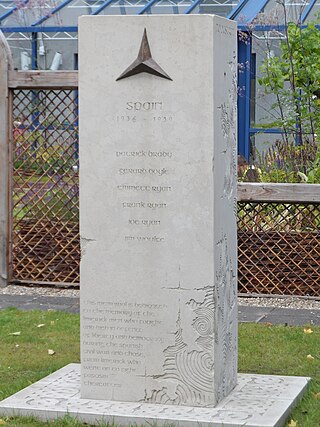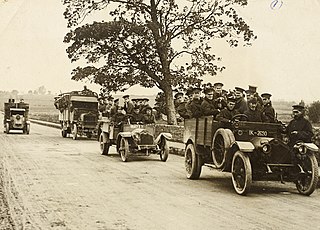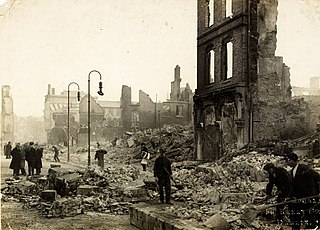Related Research Articles

Cobh, known from 1849 until 1920 as Queenstown, is a seaport town on the south coast of County Cork, Ireland. With a population of 14,418 inhabitants at the 2022 census, Cobh is on the south side of Great Island in Cork Harbour and home to Ireland's only dedicated cruise terminal. Tourism in the area draws on the maritime and emigration legacy of the town.

Cork Harbour is a natural harbour and river estuary at the mouth of the River Lee in County Cork, Ireland. It is one of several which lay claim to the title of "second largest natural harbour in the world by navigational area". Other contenders include Halifax Harbour in Canada, Trincomalee Harbour in Sri Lanka and Poole Harbour in England.

Great Island is an island in Cork Harbour, at the mouth of the River Lee and close to the city of Cork, Ireland. The largest town on the island is Cobh. The island's economic and social history has historically been linked to the naval, ship-building, and shipping activities in the town's environs.

Thomas Bernardine Barry, better known as Tom Barry, was a prominent guerrilla leader in the Irish Republican Army (IRA) during the Irish War of Independence and the Irish Civil War. He is best remembered for orchestrating the Kilmichael ambush, in which he and his column wiped out a 18-man patrol of Auxiliaries, killing sixteen men.

The Rolls-Royce armoured car is a British armoured car developed in 1914 and used during the First World War, Irish Civil War, the inter-war period in Imperial Air Control in Transjordan, Palestine and Mesopotamia, and in the early stages of the Second World War in the Middle East and North Africa.

Following the establishment of the Irish Free State, three deep water Treaty Ports at Berehaven, Spike Island, and Lough Swilly were retained by the United Kingdom in accordance with the Anglo-Irish Treaty of 6 December 1921.

Bere Island or Bear Island is an island in Bantry Bay off the Beara Peninsula in County Cork, Ireland. It spans roughly 10 km x 3 km, with an area of 17.68 km2 and, as of the 2022 census, had a population of 218 people.

Spike Island is an island of 103 acres (42 ha) in Cork Harbour, Ireland. Originally the site of a monastic settlement, the island is dominated by an 18th-century bastion fort now named Fort Mitchel.

The Rolls-Royce Silver Ghost name refers both to a car model and one specific car from that series. Originally named the "40/50 h.p." the chassis was first made at Royce's Manchester works, with production moving to Derby in July 1908, and also, between 1921 and 1926, in Springfield, Massachusetts, USA. Chassis no. 60551, registered AX 201, was the car that was originally given the name "Silver Ghost". Other 40/50 hp cars were also given names, but the Silver Ghost title was taken up by the press, and soon all 40/50s were called by the name, a fact not officially recognised by Rolls-Royce until 1925, when the Phantom range was launched.

The Connolly Column was the name given to a group of Irish republican socialist volunteers who fought for the Second Spanish Republic in the International Brigades during the Spanish Civil War. They were named after James Connolly, the executed leader of the Irish Citizen Army. They were a company-strength unit of the XV International Brigade, which also included the US, British and Latin American battalions in Spain. The name is now retroactively applied to all Irish volunteers who fought for the Spanish Republic.

This is a timeline of the Irish War of Independence of 1919–21. The Irish War of Independence was a guerrilla conflict and most of the fighting was conducted on a small scale by the standards of conventional warfare.

The Loughgall ambush took place on 8 May 1987 in the village of Loughgall, County Armagh, Northern Ireland. An eight-man unit of the Provisional Irish Republican Army (IRA) launched an attack on the Royal Ulster Constabulary (RUC) base in the village. An IRA member drove a digger with a bomb in its bucket through the perimeter fence, while the rest of the unit arrived in a van and fired on the building. The bomb exploded and destroyed almost half of the base. Soldiers from the British Army's Special Air Service (SAS) then returned fire both from within the base and from hidden positions around it in a pre-planned ambush, killing all of the attackers. Two of them were subsequently found to have been unarmed when they were killed.

Mourne Abbey, or Mourneabbey, is a small civil and Roman Catholic parish in the barony of Barretts, northwest County Cork, Ireland. The parish is situated just south of Mallow, on the main Mallow-Cork Road and Rail Line. The population of the parish is about 1,000 people. There are two churches and schools in the area, Analeentha and Burnfort. The civil parish consists of 17 townlands.
Daniel "Sandow" O'Donovan, was a leading member of the Irish Republican Army during the Irish War of Independence.

Little Island, County Cork, is a civil parish and mainly industrial area to the east of Cork city in Ireland. It is no longer an island since the northern channel separating it from the mainland has filled over. To the west and south is Lough Mahon, part of Cork Harbour; across a channel to the east is Fota Island. Little Island is within the Dáil constituency of Cork North-Central.

SS Libau was a merchant steam ship. In 1916 she was disguised with the identity of a Norwegian vessel named the SS Aud in an attempt to carry arms from Germany to Ireland as part of the preparation for the Easter Rising.

The burning of Cork by British forces took place on the night of 11–12 December 1920, during the Irish War of Independence. It followed an Irish Republican Army (IRA) ambush of a British Auxiliary patrol in the city, which wounded twelve Auxiliaries, one fatally. In retaliation, the Auxiliaries, Black and Tans and British soldiers burned homes near the ambush site, before looting and burning numerous buildings in the centre of Cork, Ireland's third-biggest city. Many Irish civilians reported being beaten, shot at, and robbed by British forces. Firefighters testified that British forces hindered their attempts to tackle the blazes by intimidation, cutting their hoses and shooting at them. Two unarmed IRA volunteers were also shot dead at their home in the north of the city.

The Port of Cork is the main port serving the south of Ireland, County Cork and Cork City. It is one of the three "Ports of National Significance " as designated by National Ports Policy.

The National Army, sometimes unofficially referred to as the Free State army or the Regulars, was the army of the Irish Free State from January 1922 until October 1924. Its role in this period was defined by its service in the Irish Civil War, in defence of the institutions established by the Anglo-Irish Treaty. Michael Collins was the army's first commander-in-chief until his death in August 1922.

Cove Fort is a small bastioned land battery to the east of Cobh in County Cork, Ireland. Built as a coastal defence fortification in 1743, on instruction of the then Vice-Admiral of the Coast, it replaced a number of temporary coastal artillery batteries which defended Cork Harbour.
References
- 1 2 Power, David; Museum, Curragh Military (30 December 1921). "A 1919 Rolls Royce Silver Ghost, nicknamed the 'moon car' because of its use at night in Cork by an IRA unit". source.southdublinlibraries.ie. Retrieved 10 September 2020.
- 1 2 3 4 5 Michael, Neil (13 January 2020). "Rolls Royce 'Moon Car' donated to National Museum". Irish Examiner. Retrieved 10 September 2020.
- 1 2 3 4 "Historic Moon Car donation made to National Museum of Ireland". National Museum of Ireland. Retrieved 13 September 2020.
- 1 2 3 O’Riordan, Sean (5 March 2013). "Restorer refuses to give up the ghost on Rolls". Irish Examiner. Retrieved 11 September 2020.
- 1 2 O'Shea, Joe (9 January 2020). "Infamous Cork 'IRA Rolls Royce' donated to the State". Cork Beo. Retrieved 10 September 2020.
- ↑ O’Donchu, Brian (23 April 2012). "FRANK BUSTEED CORK IRA NO. 1 BRIGADE". Irish Volunteers.org. Retrieved 13 September 2020.
- ↑ "Moon Car returns to scene of crime". Cobh Edition. 7 March 2019. Retrieved 13 September 2020.
- 1 2 O'Riordan, Sean (7 June 2013). "Iconic IRA vehicles roll into Cork". Irish Examiner. Retrieved 11 September 2020.
- ↑ "A very special visitor to Cobh this Saturday (6th May) | Death on the Pier". 27 January 2019. Archived from the original on 27 January 2019. Retrieved 1 November 2021.